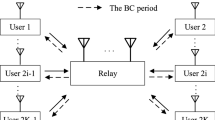Abstract
The issue of antenna correlation in multi-pair massive antenna relay network is studied. Under the spatial correlation properties of the channel, an analytical approximation for both upper and lower bounds using popular maximum ratio combining/maximum ratio transmission relaying scheme is developed. This gives an insight of the system achievable rate by exploiting channel reciprocity in the time-division duplex protocol. To this aim five special antenna correlation cases are discussed and the corresponding overall spectral efficiency is analyzed. The performance of the scheme is compared against the other precoding and receiver combining schemes, i.e., zero forcing and minimum-mean-squared-error processing under the antenna correlation model. The analytical results backed up by simulations clearly quantify the impacts of antenna correlation under various cases on user spectral efficiency.







Similar content being viewed by others
References
Marzetta, T. L. (2010). Noncooperative cellular wireless with unlimited numbers of base station antennas. IEEE Transactions on Wireless Communications, 9(11), 3590–3600. https://doi.org/10.1109/TWC.2010.
Larsson, E. G., et al. (2014). Massive MIMO for next generation wireless systems. IEEE Communications Magazine, 52(2), 186–195. https://doi.org/10.1109/MCOM.2014.6736761.
Bjrnson, E., et al. (2014). Massive MIMO systems with non-ideal hardware: Energy efficiency, estimation, and capacity limits. IEEE Transactions on Information Theory, 60(11), 7112–7139. https://doi.org/10.1109/TIT.2014.2354403.
Gao, X. et al. (2011). Linear Pre-coding performance in measured very-large MIMO channels. In 2011 IEEE vehicular technology conference (VTC Fall). https://doi.org/10.1109/VETECF.2011.6093291.
Hoydis, J. et al. (2012). Channel measurements for large antenna arrays. In 2012 international symposium on wireless communication systems (ISWCS). https://doi.org/10.1109/ISWCS.2012.6328480.
Zhang, H., et al. (2017). Downlink energy efficiency of power allocation and wireless backhaul bandwidth allocation in heterogeneous small cell networks. IEEE transactions on communications. https://doi.org/10.1109/TCOMM.2017.2763623.
Zhang, H., et al. (2017). Sensing time optimization and power control for energy efficient cognitive small cell with imperfect hybrid spectrum sensing. IEEE Transactions on Wireless Communications, 16(2), 730–743. https://doi.org/10.1109/TWC.2016.2628821.
Zhang, H., et al. (2017). Energy efficient user association and power allocation in millimeter-wave-based ultra dense networks with energy harvesting base stations. IEEE Journal on Selected Areas in Communications, 35(9), 1936–1947. https://doi.org/10.1109/JSAC.2017.2720898.
Ho, C. D., et al. (2017). On the performance of zero-forcing processing in multi-way massive MIMO relay networks. IEEE Communications Letters, 21(4), 849–852. https://doi.org/10.1109/LCOMM.2017.2648795.
Jin, S., et al. (2015). Ergodic rate analysis for multipair massive MIMO two-way relay networks. IEEE Transactions on Wireless Communications, 14(3), 1480–1491. https://doi.org/10.1109/TWC.2014.2367503.
Mallik, R. K. (2008). Distribution of inner product of two complex gaussian vectors and its application to MPSK performance. In 2008 IEEE international conference on communications. https://doi.org/10.1109/ICC.2008.866.
Zhu, G., et al. (2014). Ergodic capacity comparison of different relay precoding schemes in dual-hop AF systems with co-channel interference. IEEE Transactions on Communications, 62(7), 2314–2328. https://doi.org/10.1109/TCOMM.2014.2329492.
Zhu, G., et al. (2014). Outage probability of dual-hop multiple antenna AF systems with linear processing in the presence of co-channel interference. IEEE Transactions on Wireless Communications, 13(4), 2308–2321. https://doi.org/10.1109/TWC.2014.030514.131497.
Amarasuriya, G. (Dec 2015). Sum rate analysis for multi-user massive MIMO relay networks. In 2015 IEEE global communications conference (GLOBECOM). https://doi.org/10.1109/GLOCOM.2015.7417876.
Amarasuriya, G., & Poor, H. V. (2015). Multi-user relay networks with massive MIMO. In 2015 IEEE international conference on communications (ICC). https://doi.org/10.1109/ICC.2015.7248622.
Amarasuriya, G., & Poor, H. V. (2015). Impact of channel aging in multi-way relay networks with massive MIMO. In 2015 IEEE international conference on communications (ICC). https://doi.org/10.1109/ICC.2015.7248611.
Jia, X., et al. (2015). Spectrum and energy efficiencies for multiuser pairs massive MIMO systems with full-duplex amplify-and-forward relay. IEEE Access, 3, 1907–1918. https://doi.org/10.1109/ACCESS.2015.2486039.
Le, T. V. T., & Kim, Y. H. (2015). Power and spectral efficiency of multi-pair massive antenna relaying systems with zero-forcing relay beamforming. IEEE Communications Letters, 19(2), 243–246. https://doi.org/10.1109/LCOMM.2014.2382575.
Wang, Y., et al. (2015). Ergodic rate analysis for massive MIMO relay systems with multi-pair users under imperfect CSI. In 2015 IEEE global conference on signal and information processing (GlobalSIP). https://doi.org/10.1109/GlobalSIP.2015.7416931.
Xu, W., et al. (2017). Spectral and energy efficiency of multi-pair massive MIMO relay network with hybrid processing. IEEE Transactions on Communications, 65(9), 3794–3809. https://doi.org/10.1109/TCOMM.2017.2715170.
Zhang, Z., et al. (2016). Spectral and Energy efficiency of multipair two-way full-duplex relay systems with massive MIMO. IEEE Journal on Selected Areas in Communications, 34(4), 848–863. https://doi.org/10.1109/JSAC.2016.2544458.
Sun, X., et al. (2016). Multi-pair two-way massive MIMO AF full-duplex relaying with imperfect CSI over ricean fading channels. IEEE Access, 4, 4933–4945. https://doi.org/10.1109/ACCESS.2016.2595590.
Wang, Q., & Jing, Y. (2017). Performance analysis and scaling law of MRC/MRT relaying with CSI error in multi-pair massive MIMO systems. IEEE Transactions on Wireless Communications, 16(9), 5882–5896. https://doi.org/10.1109/TWC.2017.2717399.
Zhang, Z., et al. (2015). On capacity of two-way massive MIMO full-duplex relay systems. In 2015 IEEE international conference on communications (ICC). https://doi.org/10.1109/ICC.2015.7249003.
Bjrnson, E., et al. (2015). Optimal design of energy-efficient multi-user MIMO systems: Is massive MIMO the answer? IEEE Transactions on Wireless Communications, 14(6), 3059–3075. https://doi.org/10.1109/TWC.2015.2400437.
Mardani, M.R., et al. (2017) Delay-sensitive resource allocation for relay-aided M2M communication over LTE-advanced networks. In 2017 IEEE symposium on computers and communications (ISCC). https://doi.org/10.1109/ISCC.2017.8024661.
Hasan, M., Hossain, E., & Kim, D. I. (2014). Resource allocation under channel uncertainties for relay-aided device-to-device communication underlaying LTE-A cellular networks. IEEE Transactions on Wireless Communications, 13(4), 2322–2338. https://doi.org/10.1109/TWC.2014.031314.131651.
Bjornson, E., Matthaiou, M., & Debbah, M. (2013). A new look at dual-hop re- laying: Performance limits with hardware impairments. In IEEE Trans- actions on communications. https://doi.org/10.1109/TCOMM.2013.100913.130282.
Tulino, Antonia M., Verdú, Sergio, et al. (2004). Random matrix theory and wireless communications. Foundations and Trends® in Communications and Information Theory, 1(1), 1–182.
Author information
Authors and Affiliations
Corresponding author
Rights and permissions
About this article
Cite this article
Mardani, M.R., Mohebi, S. & Ghanbari, M. On the achievable rate bounds in multi-pair massive antenna relaying with correlated antennas. Wireless Netw 25, 1057–1065 (2019). https://doi.org/10.1007/s11276-018-1671-x
Published:
Issue Date:
DOI: https://doi.org/10.1007/s11276-018-1671-x



